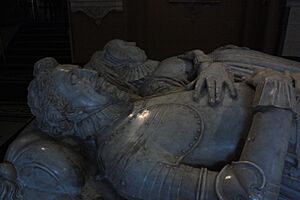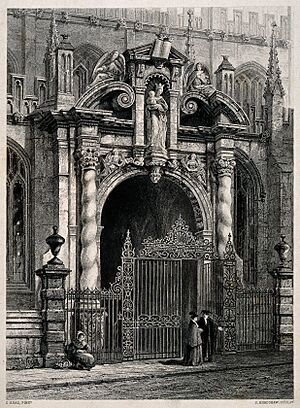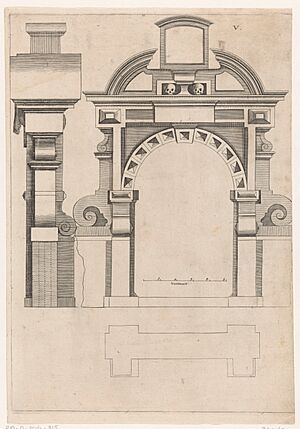Nicholas Stone facts for kids
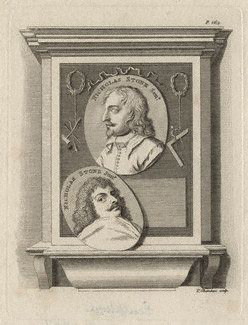
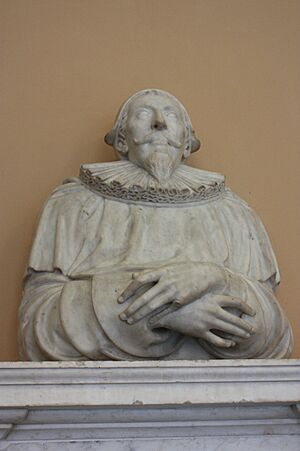
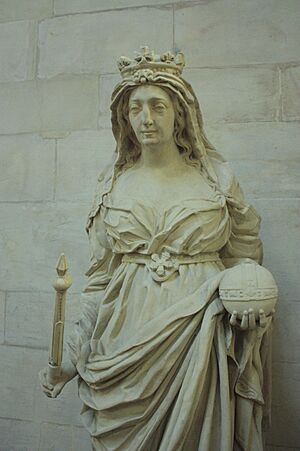
Nicholas Stone (born 1586 or 1587 – died 1647) was a very important English sculptor and architect. He was so good that in 1619, he became the master-mason for King James I. Later, in 1626, he got the same job for King Charles I.
Nicholas Stone was known for building amazing structures and creating beautiful funerary monuments. These monuments were like grand sculptures made for important people after they died. His designs were very new and exciting for England at the time. As an architect, he used the Baroque style, which was a bold and dramatic way of building. He helped bring this style to England, even though it didn't become super popular until much later.
Most sculptors back then were also "mason-sculptors." This means they combined sculpting with building. Nicholas Stone's workshop made many different pieces. He learned a lot from Dutch artists, but he also started using ideas from ancient Roman art. During his time, most sculpture jobs in England were for tombs, so he became very skilled at making them.
Contents
Early Life of Nicholas Stone
Nicholas Stone was born in 1586 in Woodbury, near Exeter. His father was a quarryman, someone who cuts stone from the ground. Nicholas first learned his trade from Isaac James, a Dutch mason in London.
In 1606, a famous Dutch sculptor named Hendrik de Keyser visited London. Nicholas Stone met him and went to work for him in Holland. While there, he married de Keyser's daughter and worked with his son, Pieter. People think Stone helped build the front entrance of the Zuiderkerk church in Amsterdam. In 1613, he came back to London and set up his own workshop. He quickly became the best English sculptor for funeral monuments.
Nicholas Stone's Famous Works
Nicholas Stone's early success in London was partly thanks to Inigo Jones, the King's Surveyor (a top architect for the King). In 1616, Stone was hired to decorate the chapel at Holyrood Palace in Scotland. He carved a wooden screen, seats, and an organ case in London, then went to Scotland to make sure everything was installed correctly.
This royal connection led to a huge job: building Inigo Jones's Banqueting House, Whitehall. This project made Stone one of the most important builders in London.
Recording His Projects
Throughout his life, Stone kept two detailed journals. These books recorded all his projects and the people who hired him. They give us amazing information about what it was like to be an architect (or "surveyor" as they were called) back then. This information shows that by 1629, he was England's top sculptor. By the end of his life, he was just as important in architecture. In 1626, he became the "master mason and architect" for Windsor Castle. In 1632, he became the Master Mason to the Crown.
Sculptures and Monuments
While Stone's workshop made garden statues and things like fancy fireplaces, most of his surviving sculptures are funerary monuments. These are how we judge his amazing sculpting skills today. Stone was very interested in the new classical style of art from Italy. You can see this in his memorials in Westminster Abbey for Sir John Holles and his brother Francis. They are dressed in Roman armor, which was a new idea in England.
One of Stone's most famous works is the monument to Dr. John Donne (a famous poet) in St Paul's Cathedral. It shows the poet standing on an urn, wrapped in a winding cloth, as if he's rising for judgment. This unique idea came from Donne himself and was sculpted from a painting he posed for.
Another masterpiece is the statue of Elizabeth, Lady Carey in the church at Stowe Nine Churches. Other examples of his monuments include those for Sir Francis Vere, Sir Dudley Digges, and the composer Orlando Gibbons.
Very few of Stone's non-tomb sculptures still exist. There's a fireplace at Newburgh Priory, some crumbling garden statues at Blickling Hall, and a collection of statues at Wilton House. The statues at Wilton House show how closely Stone worked with Inigo Jones and Isaac de Caus, who also designed parts of Wilton.
York House Water Gate
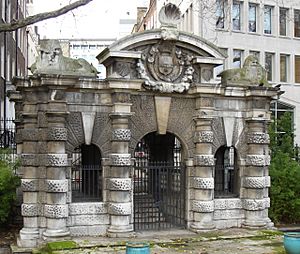

York House was a grand home along the Thames River in London. In the 1620s, it belonged to the Duke of Buckingham. He had a water gate built in 1623 to get to the Thames from his gardens. This gate is one of the few things left in London from the Italian-style court of King Charles I. Many believe Nicholas Stone designed it.
The water gate looks a lot like another gate Stone designed, the Danby Gate. It has a bold, rough stone design called "rustication." Today, only the water gate remains of York House. The house was torn down in 1670. Now, because the river's edge was changed, the gate is far from the water.
The Danby Gateway, Oxford
The Danby gateway is one of three entrances to the University of Oxford Botanic Garden. Nicholas Stone designed it between 1632 and 1633. This arch is very fancy and doesn't follow the simple classical style that was popular then. Instead, Stone was inspired by a picture in a book of arches by an artist named Serlio.
The gateway has three sections, each with a triangular top called a pediment. The middle section is set back a bit. The stone is heavily decorated with rough and smooth bands. The side sections have round columns with statues of King Charles I and King Charles II. The middle pediment has a bust (a head and shoulders sculpture) of The 1st Earl of Danby, who started the garden.
Porch of St Mary the Virgin, Oxford
In 1637, Stone designed a new entrance porch for the University Church of St Mary the Virgin in Oxford. This was one of his most amazing works, designed in a European Baroque style. The porch has a huge, curvy pediment supported by two massive twisted columns. These columns were a new and exciting feature in Baroque art, famously used in St. Peter's Basilica in Rome.
The porch's European style, which looked a bit Catholic, caused problems for its patron, Archbishop Laud. In the center of the pediment was a statue of the Virgin Mary and Child. Some people thought this was a form of Roman Catholic idolatry (worshipping images). This statue was later used against the Archbishop when he was put on trial. Even today, the statue has bullet holes from when soldiers fired at it during the English Civil War.
Goldsmiths' Hall
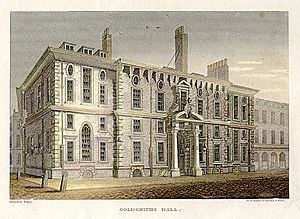
Stone designed and built Goldsmiths' Hall in London from 1635 to 1638. This building showed how Inigo Jones's ideas about architecture were spreading in England. Stone was in charge of all the workers for this new hall. This was one of the first times outside of royal projects that a "surveyor" (like an architect) was hired to oversee every detail.
Stone's Goldsmiths' Hall was very modern for its time. It had smaller windows that showed there were mezzanine floors (half-floors) inside. These floors had smaller, informal rooms and even servant's rooms. This was a big step in English home design, as servants started to have their own separate areas. The hall also had a massive porch with a broken, curvy pediment, which was a strong Baroque feature.
Sadly, Stone's Goldsmiths' Hall was mostly destroyed in the Great Fire of London in 1666. It was rebuilt but eventually torn down in 1829.
Nicholas Stone's Family and Challenges
In 1613, Nicholas Stone married Mayken de Keyser, the daughter of his old teacher, Hendrik de Keyser. They moved back to England and lived in London for the rest of their lives. They had three sons:
- John (1620–1667), who also became a sculptor.
- Henry (1616–1653), an artist known for copying paintings.
- Nicholas (1618–1647), a sculptor who even worked with the famous artist Bernini in Rome.
The start of the English Civil War stopped Stone's career. He faced difficulties because he was seen as a royal architect. His son, John, even fought for the King's side during the war. After the war, it was said that Stone had been "sequestered, plundered and imprisoned" because he was loyal to the King.
Nicholas Stone's Legacy
Nicholas Stone passed away in London on August 24, 1647. He was buried in the church at St Martin-in-the-Fields. The special memorial tablet for him, which he created for himself, has been lost. Only a drawing of it remains.
Even though Nicholas Stone was the Master Mason to the Crown and created amazing works for important people, he was often seen as just a skilled craftsman. It was another sculptor, Hubert Le Sueur, who helped raise the status of sculptors to that of true artists.
Today, we see Stone's architecture as a mix of Inigo Jones's elegant classical style and a more rough, dramatic style popular at the time. He was ahead of his time by using the Baroque style when others were still focused on a different look. It took many years after Stone's death for the Baroque style to truly become popular in England.


